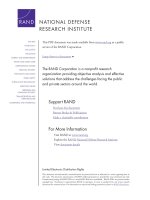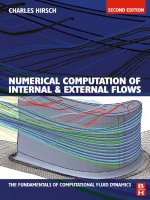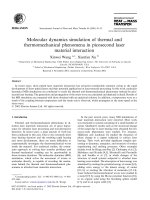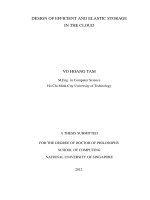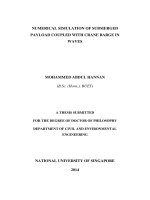Numerical simulation of interfacial and multiphase flows using the front tracking method
Bạn đang xem bản rút gọn của tài liệu. Xem và tải ngay bản đầy đủ của tài liệu tại đây (3.52 MB, 154 trang )
NUMERICAL SIMULATION OF
INTERFACIAL AND MULTIPHASE FLOWS
USING THE FRONT TRACKING METHOD
JAN FRODE STENE
(MASTER OF SCIENCE
NORWEGIAN UNIVERSITY OF SCIENCE AND TECHNOLOGY)
A THESIS SUBMITTED FOR THE DEGREE
OF DOCTOR OF PHILOSOPHY
DEPARTMENT OF MATHEMATICS
NATIONAL UNIVERSITY OF SINGAPORE
2010Acknowledgements
I would first and foremost like to express my sincere gratitude towards my su-
pervisors, Professor Lin Ping and Dr. Hua Jinsong, for their continued guidance
and generous support throughout my PhD endeavours. Thanks also go to Pro-
fessor Bao Weizhu who kindly filled the role as my NUS supervisor towards
the end of my studies, and support staff has always made sure administrative
matters have run smoothly. In addition, I am very much indebted to Professor
Helmer Aslaksen who has been most helpful in personal as well as top-level
academic matters.
The research scholarship provided by NUS, which gave me the opportunity
to pursue this PhD in the first place, is gratefully acknowledged. I have also
greatly benefited from the excellent facilities available throughout NUS, and
many thanks go to the Institute of High Performance Computing (IHPC) for
providing the state-of-the-art supercomputing resources necessary to obtain the
extensive simulation results in the current work.
I finally thank the numerous professors and fellow students from whom I
have learned so much, both at NUS and at my previous university NTNU in
Norway.
London, United Kingdom Jan Frode Stene
January 2010
i
ii
Contents
Acknowledgements i
Contents iii
Summary vii
List of Tables ix
List of Figures xi
1 Introduction 1
2 Model Problem and Computational Techniques 7
2.1 Introduction . . . . . . . . . . . . . . . . . . . . . . . . . . . . . 7
2.2 Model and governing equations . . . . . . . . . . . . . . . . . . 9
2.2.1 Mass conservation . . . . . . . . . . . . . . . . . . . . . . 10
2.2.2 Momentum conservation . . . . . . . . . . . . . . . . . . 11
2.2.3 Non-dimensional governing equations . . . . . . . . . . . 15
2.3 Overview of main computational techniques . . . . . . . . . . . 18
2.3.1 The fluid-fluid interface . . . . . . . . . . . . . . . . . . . 19
2.3.2 The equations governing the flow field . . . . . . . . . . 20
iii
CONTENTS iv
3 Front Tracking for Two-Phase Flow: The Method 23
3.1 Introduction . . . . . . . . . . . . . . . . . . . . . . . . . . . . . 23
3.1.1 A brief history of the front tracking approach . . . . . . 23
3.1.2 Motivation and strengths of current approach . . . . . . 26
3.2 Front tracking as adopted in this study . . . . . . . . . . . . . . 27
3.2.1 Overview . . . . . . . . . . . . . . . . . . . . . . . . . . 27
3.2.2 A smooth indicator function . . . . . . . . . . . . . . . . 29
3.2.3 The surface tension term . . . . . . . . . . . . . . . . . . 31
3.2.4 Evolving the interface . . . . . . . . . . . . . . . . . . . 33
3.2.5 Mesh adaptation: The front mesh . . . . . . . . . . . . . 35
3.3 The flow solver: Modified SIMPLE . . . . . . . . . . . . . . . . 37
3.3.1 A projection-correction solver . . . . . . . . . . . . . . . 37
3.3.2 A semi-implicit finite volume solver . . . . . . . . . . . . 39
3.3.3 Mesh adaptation: The background grid . . . . . . . . . . 42
3.4 Moving reference frame . . . . . . . . . . . . . . . . . . . . . . . 44
3.5 Boundary conditions . . . . . . . . . . . . . . . . . . . . . . . . 46
3.6 Summary: Solution procedure . . . . . . . . . . . . . . . . . . . 48
4 Front Tracking for Two-Phase Flow: Numerical Results 49
4.1 Introduction . . . . . . . . . . . . . . . . . . . . . . . . . . . . . 49
4.2 Sensitivity analysis . . . . . . . . . . . . . . . . . . . . . . . . . 50
4.2.1 Domain size . . . . . . . . . . . . . . . . . . . . . . . . . 50
4.2.2 Mesh resolution . . . . . . . . . . . . . . . . . . . . . . . 54
4.2.3 Moving reference frame . . . . . . . . . . . . . . . . . . . 58
4.3 Validation . . . . . . . . . . . . . . . . . . . . . . . . . . . . . . 65
4.3.1 Rising bubbles: Shapes and terminal velocities . . . . . . 66
4.3.2 The air-water system . . . . . . . . . . . . . . . . . . . . 68
CONTENTS v
5 Path Instability of Rising Bubbles 73
5.1 Introduction . . . . . . . . . . . . . . . . . . . . . . . . . . . . . 73
5.2 Numerical simulation of bubble path instability . . . . . . . . . 74
5.2.1 Review of existing numerical results . . . . . . . . . . . . 74
5.2.2 Our numerical results . . . . . . . . . . . . . . . . . . . . 76
6 Bubble-bubble Interaction 83
6.1 Introduction . . . . . . . . . . . . . . . . . . . . . . . . . . . . . 83
6.1.1 Background and motivation . . . . . . . . . . . . . . . . 84
6.2 Numerical simulations of bubble-bubble interaction . . . . . . . 84
6.2.1 Review of existing numerical results . . . . . . . . . . . . 84
6.2.2 Our numerical results . . . . . . . . . . . . . . . . . . . . 86
7 A Sequential Regularization Method for Two-phase Flow 95
7.1 Introduction . . . . . . . . . . . . . . . . . . . . . . . . . . . . . 95
7.1.1 Background and motivation . . . . . . . . . . . . . . . . 96
7.2 A SIMPLE-SR method in two dimensions . . . . . . . . . . . . 98
7.2.1 The SIMPLE algorithm in 2D . . . . . . . . . . . . . . . 100
7.2.2 The sequential regularization method in 2D . . . . . . . 101
7.2.3 Combining SIMPLE and SRM . . . . . . . . . . . . . . . 102
7.2.4 A special case . . . . . . . . . . . . . . . . . . . . . . . . 105
7.3 Numerical results . . . . . . . . . . . . . . . . . . . . . . . . . . 108
7.3.1 Parameters of interest . . . . . . . . . . . . . . . . . . . 108
7.3.2 Results from the parameter study . . . . . . . . . . . . . 110
7.3.3 Conclusions on the SIMPLE-SR method . . . . . . . . . 116
CONTENTS vi
8 Closure 119
8.1 Conclusions . . . . . . . . . . . . . . . . . . . . . . . . . . . . . 119
8.2 Outlook and recommendations . . . . . . . . . . . . . . . . . . . 122
Summary
Multiphase flows are very common both in nature and in many industrial ap-
plications. One example is the rise of bubbles in viscous liquids, which is also
an important fundamental problem in fluid physics. This study describes the
development of a robust, fully three-dimensional direct numerical simulation
algorithm and its application to the aforementioned flows. The algorithm is
based on the front tracking method, originally proposed by Tryggvason and
his co-workers, and has been validated against experiments over a wide range
of intermediate Reynolds and Bond numbers using an axisymmetric model [J.
Hua, J. Lou, Numerical simulation of bubble rising in viscous liquid, J. Com-
put. Phys. 22 (2007) 769-795]. In the current work, this numerical algorithm
is further extended to simulate 3D bubbles rising in viscous liquids with high
Reynolds and Bond numbers and with large density and viscosity ratios repre-
sentative of the common airwater two-phase flow system. To facilitate the 3D
front tracking simulation, mesh adaptation is implemented for both the front
mesh on the bubble surface and the background mesh. On the latter mesh, the
governing NavierStokes equations for incompressible, Newtonian flow are solved
using a finite volume scheme based on the Semi-Implicit Method for Pressure-
Linked Equations (SIMPLE) algorithm, and it appears to be robust even for
high Reynolds numbers and high density and viscosity ratios. A non-inertial ref-
erence frame that moves with the rising bubble is introduced, allowing long-term
vii
SUMMARY viii
simulations of rising bubbles without having to increase the size of the compu-
tational domain. The 3D bubble surface is tracked explicitly using an adaptive,
unstructured triangular mesh. The numerical model is integrated with the soft-
ware package PARAMESH, a block-based adaptive mesh refinement (AMR)
tool developed for parallel computing. PARAMESH allows background mesh
adaptation as well as the solution of the governing equations in parallel on a
supercomputer. Further, Peskin distribution function is applied to interpolate
the variable values between the front and the background meshes.
Detailed sensitivity analysis of the numerical modelling algorithm has been
carried out, and simulation results are typically compared with experimental
data in terms of bubble shapes and rise velocities. Air bubbles rising in water are
simulated for a wider range of initial bubble diameters than reported elsewhere,
and we also investigate Leonardo’s paradox by simulating the path instability of
rising bubbles. Another application studies the interaction between two rising
bubbles and illustrates how the current method handles the merging of bubbles.
In the pursuit of improving the flow solver further, we also investigate the
reformulation of the governing flow equations through the use of a sequential
regularization method, a novel approach in the context of multiphase flows. We
conclude that the new approach appears feasible, though further work would be
required for a more definite assessment.
List of Tables
4.1 Terminal rise velocities: simulations vs experiments . . . . . . . 68
7.1 Physical parameters for two different bubble regimes . . . . . . 109
7.2 Computational set-up for testing the SIMPLE-SR method . . . 109
7.3 List of test cases with variation of the parameters . . . . . . . . 109
7.4 Residuals for an increasing number of iteration steps N . . . . . 113
ix
LIST OF TABLES x
List of Figures
3.1 Illustration of the two mesh systems used in the simulation algo-
rithm . . . . . . . . . . . . . . . . . . . . . . . . . . . . . . . . . 28
3.2 The surface tension forces exerted on a triangular surface element 33
3.3 The effect of mesh adaptation of the moving interface . . . . . . 36
3.4 Basic operations for triangular mesh adaptation. . . . . . . . . . 37
3.5 Illustration of the successive refinement levels in PARAMESH. . 43
3.6 Relation between the moving and stationary reference frames . . 47
4.1 Sensitivity analysis case A4: size of the computational domain. . 52
4.2 Sensitivity analysis case A5: size of the computational domain. . 53
4.3 Sensitivity analysis case A4: resolution of the background grid. . 56
4.4 Sensitivity analysis case A5: resolution of the background grid. . 57
4.5 Bubble shapes in stationary and moving reference frames. . . . . 59
4.6 Transient rise velocities in stationary and moving reference frames. 60
xi
LIST OF FIGURES xii
4.7 Streamlines in stationary and moving reference frames . . . . . 61
4.7 Streamlines in stationary and moving reference frames (cont.). . 62
4.8 Pressure distributions in stationary and moving reference frames. 63
4.8 Pressure distributions in stationary and moving reference frames
(cont.) . . . . . . . . . . . . . . . . . . . . . . . . . . . . . . . . 64
4.9 Terminal bubble shapes: simulations vs experiments. . . . . . . 67
4.10 Rise velocity of air bubbles in water: simulations vs experiments. 69
4.11 Grace diagram based on simulations for air bubbles rising in water. 71
5.1 The trajectory of the mass centre of a bubble rising on a zigzag
path. . . . . . . . . . . . . . . . . . . . . . . . . . . . . . . . . . 79
5.2 The wake structure of a bubble rising on a zigzag path. . . . . . 80
5.3 The trajectory of the mass centre of a bubble rising on a spiral
path. . . . . . . . . . . . . . . . . . . . . . . . . . . . . . . . . . 81
5.4 The wake structure of a bubble rising on a spiral path. . . . . . 81
6.1 Interaction of two bubbles rising due to buoyancy (Case I). . . . 89
6.2 Vertical and lateral position of the two rising bubbles (Case I). . 90
6.3 Interaction of two bubbles rising due to buoyancy (Case II). . . 91
6.3 Interaction of two bubbles rising due to buoyancy (Case II cont.). 92
LIST OF FIGURES xiii
6.4 Vertical and lateral position of the two rising bubbles (Case II). 93
7.1 Computational set-up for the SIMPLE-SR simulations . . . . . 110
7.2 Residual in velocity u as a function of the penalty parameter . . 111
7.3 Divergence of the velocity as a function of the penalty parameter .112
7.4 Regime A: The bubble front at time t = 2.0. . . . . . . . . . . . 114
7.5 Regime A: The bubble front at time t = 4.0. . . . . . . . . . . . 114
7.6 Regime B: The bubble front at time t = 2.0. . . . . . . . . . . . 115
7.7 Regime B: The bubble front at time t = 4.0. . . . . . . . . . . . 115
7.8 Residuals in the u velocity as a function of the number of SR steps.117
7.9 Divergence of the velocity as a function of the number of SR steps.117
LIST OF FIGURES xiv
Chapter 1
Introduction
Background
Mankind has been captivated by fluid flows for millennia due to their practical
importance: the flow of water in rivers, ocean currents, wind and weather in
the atmosphere or the flow of blood in our veins. While these naturally occur-
ring phenomena remain a source of fascination, advanced industrial applications
involving complex fluid flows have also become very important in the modern
day. Examples include flow of oil and gas in wells and pipelines, fluidized beds,
distillation and bubble columns and fuel cell systems. It is clear that fluid flows
are crucial in many industries, and the understanding of these flows is therefore
essential to design safe and efficient equipment and processes. Experiments have
traditionally been used to gain insights into relevant flow physics, though this
approach has certain limitations due to one or more of the following reasons:
• Excessively expensive in terms of time or finances
1
Chapter 1. Introduction 2
• Infeasible operating conditions, e.g. explosions (too high pressures), fires
(too high temperatures) and pollution (toxic effects).
• Unacceptable interference on flow patterns from the measurement equip-
ment
An alternative way of obtaining the desired knowledge is to develop and
solve physical models describing the phenomena. The Navier-Stokes equations
form the fundamental basis for the modelling of most fluid flows and were for-
mulated almost 200 years ago. Yet, due to their complexity, it was only with
the development of the electronic computer that the early numerical solutions
could be obtained in the 1950s. Since then numerical algorithms have continu-
ously been developed and improved, and at the same time computing power has
evolved dramatically as well as become much more affordable. This has led to
the emergence and rapid growth of the field of Computational Fluid Dynamics
(CFD). While CFD has come a long way in providing key tools to a wide range
of industries, the field continues to develop and still faces many challenges in
the pursuit of ever more accurate results for increasingly complex systems.
Categories of fluid flow
It is often useful to categorize the abundance of both natural and industrial
occurring fluid flows, and a variety of categorizations are possible depending on
the point of interest. In the current work we make a distinction between single
and multiphase flows. Single phase flows involve fluids consisting of one or more
components where all components are either in the gas phase (e.g. air) or liquid
phase (e.g. sea water). Put simply we may then say that multiphase flows
encompass all other types of fluid flows. Another category is interfacial flows
Chapter 1. Introduction 3
which is characterized by the presence of an interface due the immiscibility of
two or more fluids. Single phase flows may be interfacial, e.g. flow involving
oil and water, while an interface will always be present in multiphase flows.
It is multiphase and interfacial flows that will be investigated in this thesis -
specifically in the context of gas bubbles rising in viscous liquids.
Current work and contribution
Researchers Jinsong Hua and Jing Lou at the Institute of High Performance
Computing (IHPC) in Singapore validated an improved numerical algorithm
based on the front tracking method against experiments over a wide range of
intermediate Reynolds and Bond numbers for gas bubbles rising in viscous liq-
uids using an axisymmetric model [50]. That formed the starting point of the
current work which was carried out as a research collaboration between the De-
partment of Mathematics at the National University of Singapore (NUS) and
the Computational Fluid Dynamics group at IHPC. The main objective was as
follows:
Develop a state-of-the-art three-dimensional solution algorithm ca-
pable of simulating realistic bubble flows and hence providing more
insights into the fundamentals of bubble dynamics.
The aptitude of the method that has been developed lies in the combination
of several powerful components, modifying and integrating them to obtain an
overall simulation algorithm with cutting-edge capabilities. Present contribu-
tions include:
Chapter 1. Introduction 4
• The development and implementation of a robust, fully three-dimensional
simulation algorithm with these key components:
– The moving interface is handled using a front tracking approach
– A Semi-Implicit Method for Pressure-Linked Equations (SIMPLE) is
adopted and modified to handle discontinuities present in the gov-
erning Navier-Stokes equations due the interface
– The SIMPLE flow solver is integrated with PARAMESH: a block-
based, adaptive mesh refinement (AMR) tool for multi-processing
• Simulation of flows in an extended, wider range of Reynolds and Bond
numbers for large, realistic ratios of the density and viscosity of the fluids:
– Simulation of air bubbles rising in pure water for bubble diameters
from 0.5 mm to 30 mm, far wider than other simulations reported in
the literature
– Reproduction of path instability for rising bubbles through the use
of a non-inertial moving reference frame, using less simplifying as-
sumptions than reported elsewhere in the literature
• Reformulation of the governing equations through the use of a sequential
regularization method - a novel approach in the context of multiphase
flows.
Some results of this work have been published in the Journal of Computa-
tional Physics [49] and in Moving Interface Problems and Applications in Fluid
Dynamics, a volume of Contemporary Mathematics by the American Mathe-
matical Society [47]. Highlights were also presented at the 6th International
Conference on Multiphase Flow in Leipzig, Germany, in 2007 [48], and these
publications form a very important part of this thesis.
Chapter 1. Introduction 5
Thesis outline
This thesis is structured as follows. Motivation and a detailed statement of
the model problem is given in Chapter 2 along with an overview of the main
computational techniques typically deployed to solve the problem. The specific
method of choice that is adopted and further developed in the current work is
then comprehensively described in Chapter 3. The implementation and feasibil-
ity of this method is then assessed thoroughly in Chapter 4 through sensitivity
analyses and validation against experimental results. The powerful capabilities
of the simulation algorithm is further demonstrated when applied to study two
complex multiphase phenomena: path instability of rising bubbles and the inter-
action of two rising bubbles in Chapters 5 and 6, respectively. A reformulation
of the model problem through sequential regularization and a modified solution
algorithm is investigated in Chapter 7, while Chapter 8 finally concludes this
thesis with a summary of the main conclusions and recommendations for further
work.
Chapter 1. Introduction 6
Chapter 2
Model Problem and
Computational Techniques
2.1 Introduction
In the previous chapter we illustrated how multiphase flows play an important
role in both everyday life and engineering practice. It is clear that various types
of multiphase flows can vary dramatically in terms of complexity. One basic and
important example is the rise of a single gas bubble in an otherwise quiescent
viscous liquid, e.g. a bubble of air rising in water. The understanding of the flow
dynamics of this system is of great importance in engineering applications and
to the fundamental understanding of multiphase flow physics, and it is indeed
this system that will be the model problem of choice in this thesis.
Rising bubbles have long been studied theoretically [24, 76], experimentally
[6] as well as computationally through numerical modelling [97]. While all these
efforts have provided us with valuable insights into the dynamics of bubbles
rising in viscous liquids, there are still many questions that remain unanswered
due to the involvement of complex physics. The behaviour of a bubble rising in
a viscous liquid is not only affected by the physical properties such as density
7
Chapter 2. Model Problem and Computational Techniques 8
and viscosity of both phases (see [21]), but also by the surface tension on the
interface between the two phases and by the bubble shape evolution [82, 8]. The
difficulties in describing and modelling the complex behaviour of a rising bubble
are to a large extent due to the coupling of factors such as buoyancy, surface
tension, bubble/liquid momentum inertia, viscosity, bubble shape evolution and
rise history of the bubble. Several of these factors are coupled in a highly
nonlinear manner, making the situation even more complex. In addition, the
physics of the behaviour of bubbles is of a three-dimensional nature. Due to
the enormous complexity of the fully three-dimensional governing equations,
most of the past theoretical works were done with a lot of assumptions, and the
results are thus only valid for certain flow regimes [76, 109]. Furthermore, the
experimental works were limited by the available technologies to monitor, probe
and sense the moving bubbles without interfering with their physics [6, 111, 104].
We have mentioned both theoretical and experimental difficulties that re-
searchers face when studying bubbles rising in a viscous liquid. With the rapid
advance of computing power and the continuous improvement of numerical
methods, first principle based numerical simulations promise great potential in
extending our knowledge of multiphase flows in general, and of the fundamental
system of a single bubble rising in a viscous liquid in particular. Neverthe-
less, there are still great challenges and difficulties in simulating such a system
accurately. This may be attributed to the following facts:
1. the sharp interface between the gas bubble and the surrounding liquid
should be tracked accurately without introducing excessive numerical smear-
ing
2. the surface tension gives rise to a singular source term in the governing
equations, leading to a sharp pressure jump across the interface
Chapter 2. Model Problem and Computational Techniques 9
3. the discontinuity of the density and viscosity across the fluid interface may
lead to numerical instability, especially when the jumps in these properties
are high. For example, the density ratio of liquid to gas could be as high
as 1000
4. the geometric complexity caused by bubble deformation and possible topo-
logical change is the main difficulty in handling the geometry of the inter-
face; a large bubble may break up into several small ones, and a bubble
may also merge with other bubbles
5. the complex physics on the interface, e.g. the effects of surfactants, film
boiling and phase change (heat and mass transfer) and chemical reactions
Fortunately, various methods for multiphase flow have been developed to
address these difficulties, and each method typically has its own characteristic
strengths and weaknesses. An overview of various relevant numerical methods
will follow in Section 2.3, while the numerical methodology adopted in this thesis
is described in detail in Chapter 3. However, let us first turn our attention to
the mathematical formulation of the model problem, which will be presented in
Section 2.2
2.2 Model and governing equations
This section will establish the mathematical formulation of our model problem
and its associated notation. Much of the derivations and equations presented
here are quite standard and can be found in numerous publications on fluid
dynamics - the author found Batchelor’s classic book from 1967 particularly
useful [5]. More recent references used for this section include the Von Karman

